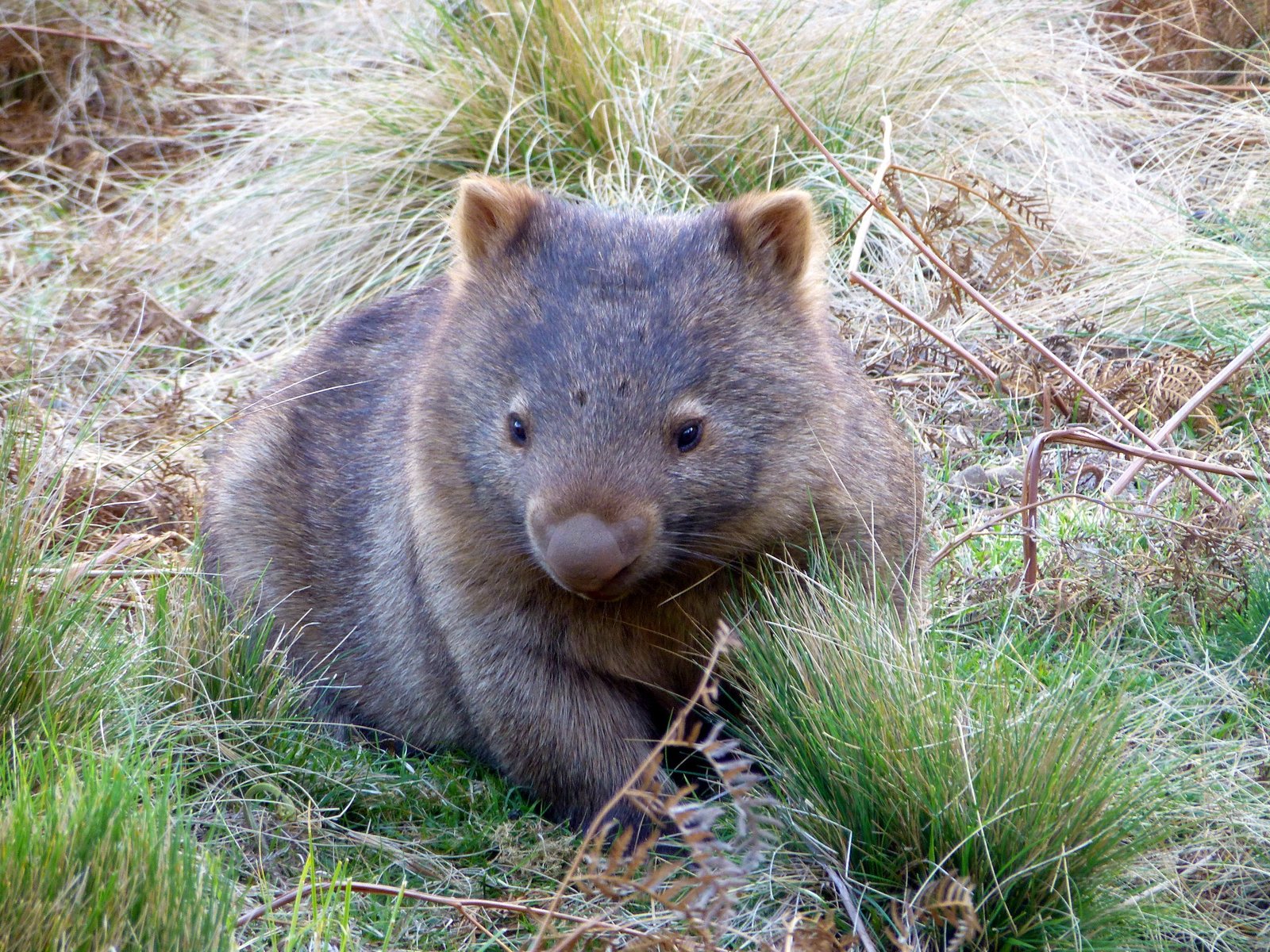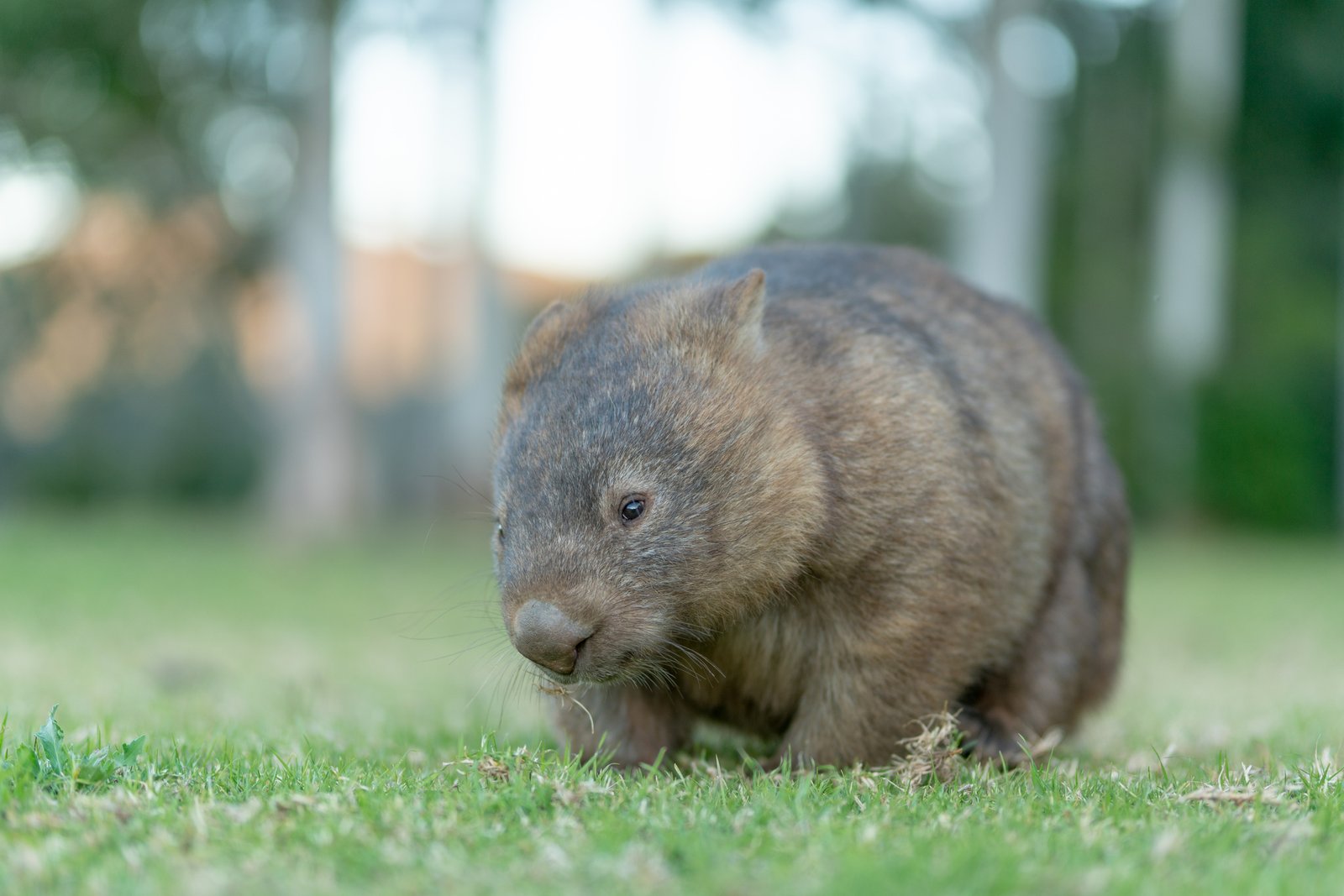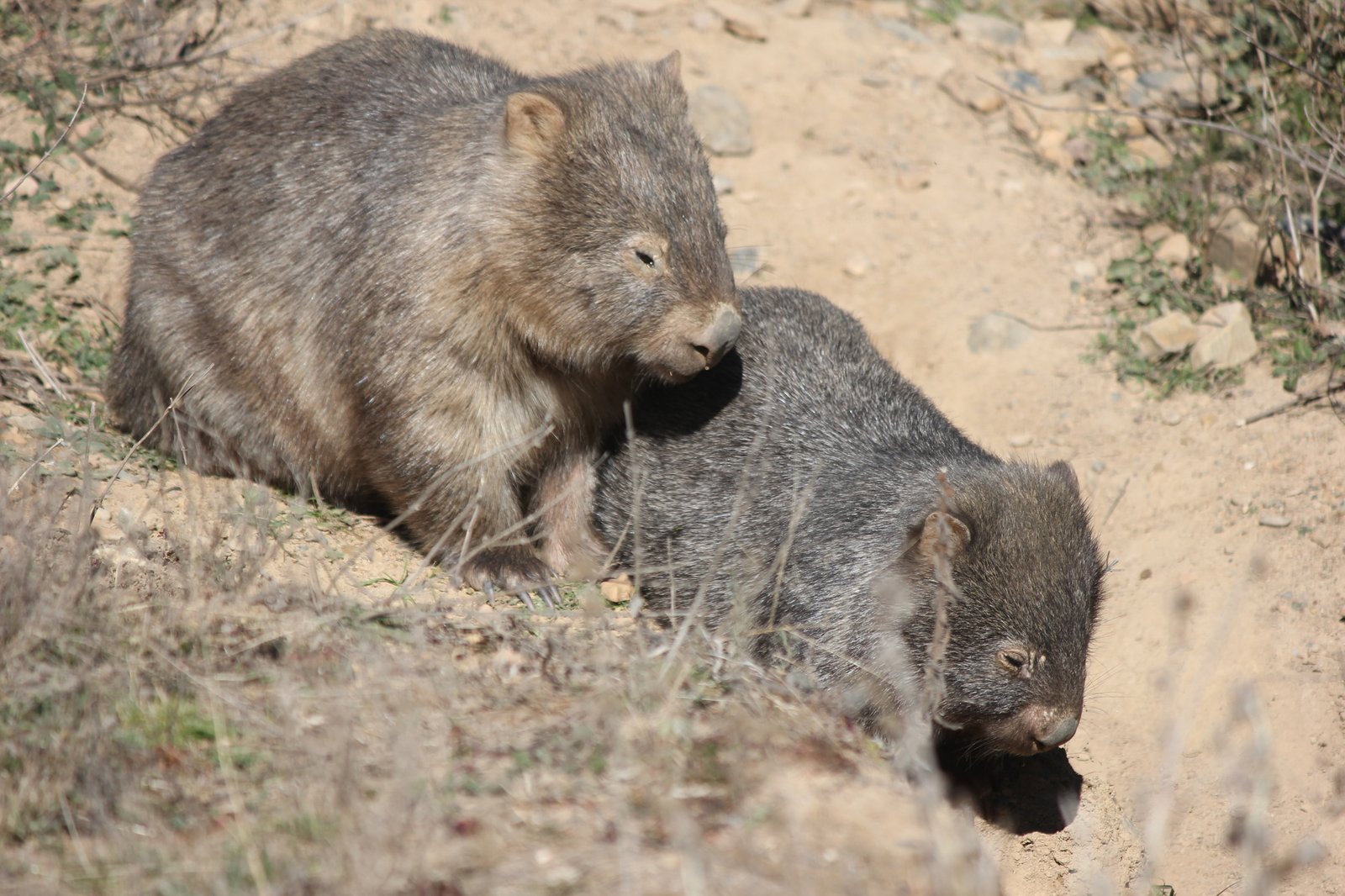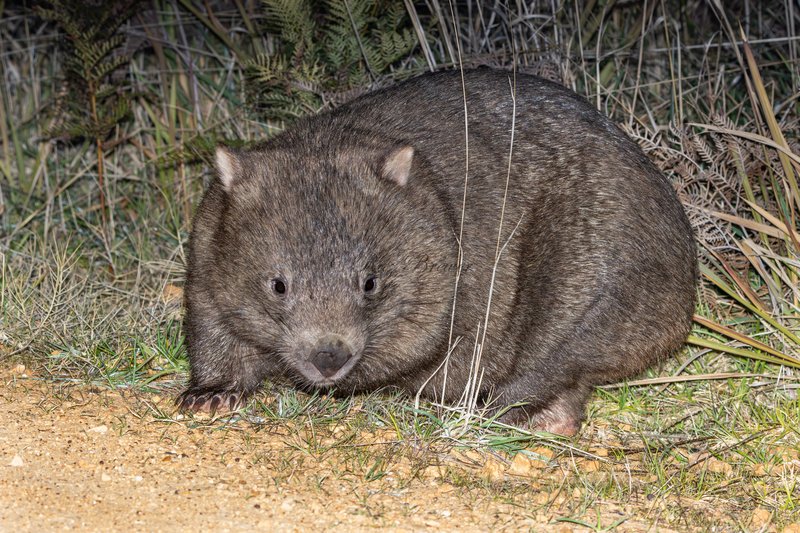Bare-nosed Wombat
Naked-nosed Wombat, Island Wombat, Tasmanian Wombat, Forest Wombat, Coarse-haired Wombat. It is also known as a Common Wombat, a term that is increasingly misleading, as it was probably associated with the species’ historic wide population distribution, which has become more fragmented.
Bare-nosed Wombat is the only living member of its genus Vombatus, and is similar in appearance to two remaining wombat species (Southern and Northern Hairy-nosed Wombats) belonging to the genus Lasiorhinus. The main differences are the absence of hair on the nose in the Bare-nosed Wombat, its coarser hair and narrower nasal bones than in Lasiorhinus. In the early descriptions of the species by the Europeans, wombats have been linked to badgers, beavers, pigs and bears (it is because of its bear-like appearance that it has been named ursinus (Latin ursus, bear)). However, other than being a mammal, the wombat is not related to these animals: wombats are marsupials (the young develop in mother’s pouch) and not placentals, like the other aforementioned mammals.
Wombats are amongst the world’s largest burrowing animals. They are equipped with powerful limbs, short broad feet and flattened claws. Wombats are primarily grazers and their continuously growing incisors work as efficient cutters of grass and forbs.
What do Bare-nosed Wombats look like?
Identification
A short, stocky, barrel-shaped animal with physical characteristics that reflect its burrowing nature. It has a broad head with small eyes, a short strong neck, powerful shoulders and a very small tail (~25 mm) hidden by fur. Colour of the wombat’s coarse coat varies from glossy black, dark grey, silver-grey, chocolate brown, grey-brown, sandy and cream. In southern Victoria, there is a small colony of ash-white wombats and albino animals have been reported, as well. Often the coat can also be coloured by the soil (e.g. clay can stain the fur red), and/or have patches that are lighter in colour.
Wombats differ from other marsupials by having only two incisor teeth in the upper jaw. The incisor and molar teeth of this animal are also unique because they have open roots and continue to grow throughout the animal’s life.
Bare-nosed Wombat’s distinguishing features are: large and naked nose; coarse thick coat; short, slightly rounded ears.

© CC BY-NC 4.0
Where do Bare-nosed Wombats live?
Habitat
The main habitat for the Bare-nosed Wombat is the temperate forest-covered areas of southeastern Australia. The species tends to avoid rainforests and is often found in the mountainous areas. In southern Queensland and northern New South Wales it is found only in sclerophyll forest above 600 m. In South Australia and Tasmania it also occurs at lower altitudes in more open vegetation – woodland, coastal scrub and heathland.
Wombats prefer to dig their main shelters on slopes above creeks and gullies, and feed in grassy clearings.
Distribution
At the time of European settlement, 200 years ago, the Bare-nosed Wombat was wide spread from southeastern Queensland, through New South Wales along the Great Dividing Range to most of Victoria (except the northwestern corner of the state). It was also present in the southeast of South Australia, in Tasmania and on many of the larger Bass Strait Islands.
Today the species has a discontinued and fragmented distribution. It has almost disappeared from the western half of Victoria and it is absent from many parts of New South Wales where it formerly ranged. In addition, it has declined in South Australia, and is now only found on Flinders Island of the Bass Strait Islands.
Specimen in our collection
View microCT scan of a Bare-nosed Wombat skull (Vombatus ursinus) from the Australian Museum Mammalogy Collection (specimen AM M.2865). Learn more about microCT scanning and how it is used by the Australian Museum Research Institute.
What do Bare-nosed Wombats eat?
Seasonality
Bare-nosed Wombat is one of the few marsupials that are active above the snowline in winter, however they appear to be less active than during warmer months. In summer, the animal is mainly nocturnal, emerging from its burrow when the air cools down, to avoid high temperatures. In general, wombats spend most of their lives (about two thirds) in their burrows.
Feeding and diet
A wombat usually leaves the burrow after sunset and begins to graze for several hours. During this time, it may return to its burrow to rest, or seek refuge, and it will return to sleep generally before sunrise. However, in cool or overcast days the animals are known to forage longer and during the day.
The main food for wombats is fibrous native grasses, sedges and rushes, and the choice of food depends on what is available at the time. Wombats seem to prefer Tussock Grass in the forest areas, and Kangaroo Grass and Wallaby Grass are favoured in open, more pastoral areas. At times when it is eating grass, a wombat will also eat dry leaves and stalks, and occasionally tear a strip of bark from a tree trunk and chew small quantities of it. In some habitats, wombats also feed on mosses, possibly as a source of water, given their low nutritional value. Anecdotal observations of wombats feeding on fungi have been reported as well.

© CC BY-NC 4.0
How do Bare-nosed Wombats communicate and what is their life cycle?
Communication
Wombats are generally classed as solitary animals despite the overlapping ranges and occasional sharing of the burrows. Therefore, communication between two individuals is often threatening or aggressive. A warning call is usually a low guttural growl, but when a wombat is alarmed or angered, rasping hiss can also be heard. The animal repeats this high, loud call as it expels air. Sometimes the call can be a more aggressive ‘chikker chikker’ sound and/or a more guttural sound similar to that of an angry brushtail possum.
Communication is also apparent between younger animals and their mothers. Young make repeated, softer ‘huh huh’ calls when they lose sight of their mother, and she usually responds in the same manner.
Life history cycle
Usually, one very small, underdeveloped wombat is born following a short gestation period (probably 30 days). It makes its way to the pouch, where it grows and develops for 6-10 months. The young then leaves the pouch and remains with its mother for further 8-10 months before becoming independent. Bare-nosed Wombats become sexually mature after two years and live up to 11 years in the wild. In captivity, individuals can live well into their twenties.
Breeding behaviours
Breeding may occur at any time of the year, with a single young being born. However, in the highlands of New South Wales, most wombats give birth during December-March, while in Tasmania there is an apparent bias towards October-January being the birthing season. On Flinders Island no births occur between September-January months.
When a female enters oestrus she becomes active and aggressive. Mating has been observed in captive wombats; the female attacked the male for about 30 minutes before allowing him to mate. The mating lasted for about 30 minutes with both male and female laying on their sides. In the wild, the courtship consists of the female being chased by the male in wide circles. The male then bites the female’s rump and rolls her over on her side. After several minutes the female breaks away and resumes the chasing behaviour. This action can be repeated several times within about 30 minutes.

© CC BY-NC 4.0
Are Bare-nosed Wombats endangered?
Conversation status
- Common species, not listed under EPBC Act 1999.
- Under IUCN the Common Wombat has been listed as Least Concern species (year assessed 2008).
Economic impacts
In eastern Victoria the species is considered a vermin due to the damage it causes to fencing. Some landholders also blame the wombats for erosion of creek and river banks, which is often far lower compared to that caused by poor farming practices: over-stocking and over-clearing, in particular.
Predators
The Bare-nosed Wombat does not have many natural predators, except the introduced ones: wild dogs and foxes. When threatened it will escape to the nearest burrow, where it can defend itself by crushing a predator’s head with its rump against the roof or wall of the burrow. In the open, an adult wombat can usually hold its own against a single dog, but it is overcome by a pair or a pack of dogs. Young, immature wombats, or old/weakened adults are, therefore, more likely to be the potential prey for the predators.
Wombats are susceptible to bacterial infections that can be difficult to treat in captivity. However, in the wild, an injured wombat will roll in earth and the soil will stick to the wounded area, allowing the area to heal with time. Similar behaviour is observed when the animal suffers from mange mite, and the soil is believed to help the animal alleviate some of the intense itchiness caused by the disease. In severe cases mange can affect the wombat’s vision and ability to eat, making the animal weaker until it eventually dies. Other external parasites commonly found on wombats include: ear mites, skin mites and ticks. Internal parasites include worms of various kinds, but these appear to do little or no harm to the animal. In areas where wombats and sheep graze together, wombats can become infected with liver fluke, a parasite common in sheep. Similarly, in the vicinity of other domestic stock, wombats can get infected with leptospirosis which causes serious kidney damage. In captivity, toxoplasmosis is a major cause of death for young, hand-reared wombats.
Other diseases recorded in wombats include diabetes, arthritis, cancer, asthma and pneumonia, however, there is limited knowledge on this aspect of wombat’s life.
Are Bare-nosed Wombats dangerous?
Danger to humans
Bare-nosed Wombats are mainly nocturnal animals and as such are not often encountered by people in the wild. However, they are strong animals and can move fast at speeds over 40 km/h over short distances. A recent, but rare attack of a wombat has been reported in April 2010 in Victoria, when a man was charged and knocked down by the animal which also mauled his leg, and left scratch marks on his chest. Danger from a wombat is mostly associated with individuals in captivity/zoo, as wombats can be perceived as affectionate pets when they are young, but can become quite aggressive as they mature. If bitten or scratched by a wombat a person should have the wounds cleaned and bandaged, and receive a tetanus shot if needed.
References
- Sexton, R. (2010) Black Saturday survivor on the run from a wild wombat. Sydney Morning Herald <http://www.smh.com.au/national/black-saturday-survivor-on-the-run-from-a-wild-wombat-20100406-rpfq.html> date accessed: 13/09/2010.
- Triggs, B. (1996) The Wombat: Common Wombats in Australia. Australian Natural History Series, University of New South Wales Press, Sydney. Pp.: xi+148.
- van Dyck, S. and Strahan, R. (eds) (2008) The Mammals of Australia. Third edition. Reed New Holland, Sydney. Pp.: 202-208.
Support the Australian Museum
Your donation supports the exceptional work of our inspiring scientists, explorers and educators as they help to protect Australia’s vital natural and cultural heritage for generations to come.
Donate now

